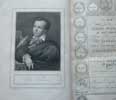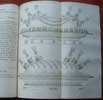L'ART DE LA CUISINE FRANÇAISE AU XIXe SIÈCLE
L'ART DE LA CUISINE FRANCAISE AU DIX-NEUVIEME SIECLE. TRAITE ELEMENTAIRE ET PRATIQUE DES BOUILLONS EN GRAS ET EN MAIGRE, DES ESSENCES, FUMETS, DES POTAGES FRANCAISE, ET ETRANGERS; DES GROSSES PIECES DE POISSON; DES GRANDES ET PETITES SAUCES; DES RAGOUTS ET DES GARNITURES; DES GROSSES PIECES DE BOUCHERIE; DE JAMBON, DE VOLAILLE ET DE GIBIER, ETC. PAR Antonin CAREME, de Paris. TOME PREMIER. PARIS. AU DEPOT DE LIBRAIRE, RUE DES MOULINS, 8 PRES DE LA RUE THERESE, 11. 1854. Volumes 4 & 5 by PLUMEREY.
5 VOLUMES -- TOME 1; Marbled endpaper. 1 fep. Half-title with Careme facsimile signature. [2] Portrait frontis of Careme. Elaborate title page (designed by Careme) [1] Title page. [1] v-vj Dedication to Madame Rothschild. vij-xix To Lady Morgan. xxj-liij Notice Historique et Culinaire. [1] lv-lxvj Avertissement. lxvij-cviij Histoire. cix-cxix Fragments. [1] cxxj-cxxvij Un Repas. [1] 1-296. (1) 298-313 Table. [1] 1fep. Marbled endpaper. Many small vignettes throughout the book. TOME 2; Marbled endpaper. 1 fep. Half-title. Elaborate title page (designed by Careme) [1] Title page. [1] j-xxviij Aphorismes. xxix-xxxj Trait de Devouement d'un Domestique. [1] (2)7-326. (1)328-342. 1fep. Marbled endpaper. Nine plates (numbered 2-10) plus many small vignettes throughout the book. TOME 3; Marbled endpaper. 1 fep. Half-title. Elaborate title page (designed by Careme) [1] Title page. [1] (1)2-519. [1] (1)522-544 Table. 1fep. Marbled endpaper. Nine plates (numbered 11-22) plus many small vignettes throughout the book. TOME 4; Marbled endpaper. 1fep. [1] Title page. [1] (1)vi-xi Preface. [1] iv-(1) 1-411. [1] (1)414-425 Table. [1] 2p Errata. 1fep. Marbled endpaper. TOME 5; Marbled endpaper. 1fep. [1] Title page. [1] (1)xiv-xxvii Disertation. [1] (1)xxx-xxxv. [1] 1-526. (1)528-539 [1] 1fep. Marbled endpaper. All five volumes with bottle green marbled boards. Black half calf. Spines with red labels and gilt lines. All volumes in good condition with very light foxing due to poor paper. Overall a handsome set.
- Marie Antoine Carême was born into a working class family in Paris in 1784. When he died in 1833, he was recognized as the greatest chef of his time, and his name was familiar to the rich and famous throughout Europe. Carême's colleagues, and the public at large, first discovered his talents with the publication of ‘Le Pâtissier Royal Parisien’ in 1815. In his great work on cookery, ‘L'art de la Cuisine Française au XIXe siècle' (1847), Carême carries his love of extravagant decoration to new heights for savory dishes. As well as standing cutlets and poultry on end and presenting them in a circle, turban style, or sticking whole fish and roasts with a wide array of decorative hatelets garnished with truffles, crayfish, cockcombs, mushrooms etc etc, he built models of monuments, buildings and ruins etc, with Pastilliage. More importantly, he entirely revamped the art of cookery itself, arguing, among other things, for a cuisine based on "velvety" sauces, rather than the thin, watery sauces favoured in the past. For developing a series of basic preparations (brown and white sauces, court-bouillons, force-meats, etc.) that would become the building blocks of classic French cuisine upon which entire families of preparations could be constructed by combining them or changing the main ingredient or a flavouring. Despite all of his modernism, Carême preferred the monumental service ‘à la française’ in which all the dishes of a given course were placed on the table at once, to the newly-introduced service ‘à la russe,’ in which they were kept hot in the kitchen, then served sequentially from platters passed by waiters. "Certainly this method of serving is conducive to good eating," he wrote, "but our service ‘à la française’ is more elegant and lavish." His influence on French cuisine was enormous, and succeeding generations of chefs continued in the paths he had traced. It was not until 1903, when Auguste Escoffier published his ‘Guide Culinaire,’ that Carême's authority was finally challenged, but his name is revered to this day as a great master whose contributions irrevocably shaped the course of French cuisine. Careme wanted to publish five volumes. Tomes one to three were completed by him before he died, with the first edition being published - 1833-1835. Armand Plumerey completed Careme's work, publishing tomes four and five in 1844; An very important and influential work.



click on image to enlarge

Antiquarian category
ref number:
11022